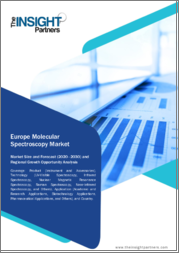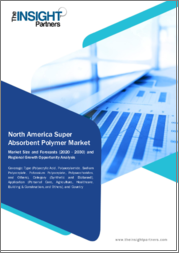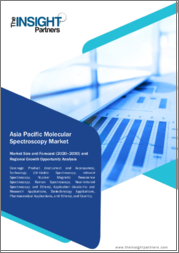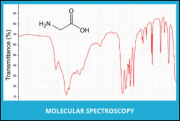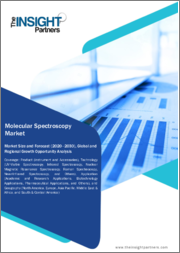
|
시장보고서
상품코드
1685717
세계의 분자분광법 시장 : 점유율 분석, 산업 동향 및 통계, 성장 예측(2025-2030년)Molecular Spectroscopy - Market Share Analysis, Industry Trends & Statistics, Growth Forecasts (2025 - 2030) |
||||||
세계의 분자분광법 시장 규모는 2025년 29억 8,000만 달러로 추정되며, 예측 기간 중(2025-2030년) CAGR 3.72%로 확대되어, 2030년에는 35억 7,000만 달러에 달할 것으로 예측됩니다.
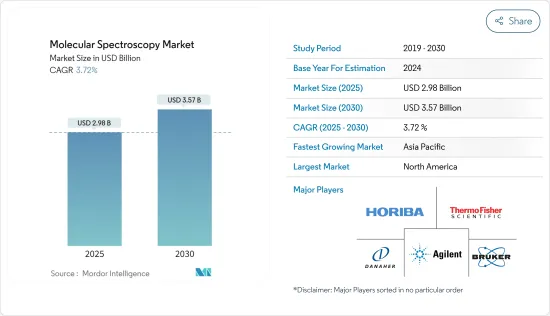
시장을 견인하는 주요 요인으로는 제약 업계에서의 급속한 채용, 다양한 업종에 MS 기술 침투, 제약 기업에 의한 신규 분자의 탐색 중시가 고조 등이 있습니다.
COVID-19의 유행이 확대되고 있는 것도, 과학자가 COVID-19 검사에 라만 분광법의 응용을 늘리고 있기 때문에 시장에 긍정적인 영향을 주고 있습니다. 예를 들어, 북아리조나대학(NAU)의 연구팀은 단일 분자 표면 증강 라만 분광법(SM-SERS)을 사용하여 SARS-CoV-2의 새로운 검사 기술을 개발하고 있는 것으로 나타났습니다. 이 프로젝트는 "단일 분자 표면 강화 라만 분광법을 이용한 SARS-CoV-2의 새로운 검사법 개발"로 명명되었으며, 전미 과학 재단의 신속 대응 연구(RAPID) 보조 프로그램에서 20만 달러의 보조금을 획득했습니다. 따라서 창약과 관련된 제약기업의 연구개발 활동이 증가함에 따라 분자분광법 수요는 예측기간 동안 일관되게 증가할 것으로 예상됩니다.
분자분광법은 의약품 및 기타 바이오테크놀러지 제품의 연구개발(R&D)에 사용되고 있으며, R&D에 사용되는 분자분광법의 하나가 근적외분광법(NIR)입니다. 화학적 및 물리적 샘플 파라미터를 기대할 수 있는 등 다른 분석 기술에는 없는 큰 이점이 있기 때문에 제약 업계에서도 널리 평가되고 있습니다.
분자분광법도 의약품을 비롯한 다양한 응용 분야에서 널리 채용되고 있는 것으로 알려져 있습니다.
라만 분광법은 구조적 활성 상관 연구, 반응 조건 최적화, 다형체 및 제형 스크리닝과 같은 기타 매개변수 최적화에 사용되며, 창약에서 개발로의 전환에 필요한 규모를 높이는 데 도움이 됩니다.
분자분광법 시장 동향
NMR 분광법 부문은 예측 기간 동안 좋은 성장이 예상됩니다.
핵자기공명(NMR) 분광법은 시료의 함유량이나 순도, 분자구조를 측정하기 위해 품질관리나 연구에 이용되는 분석화학기술입니다.
COVID-19 증례가 증가함에 따라 제약회사의 연구개발 활동에 대한 수요가 증가하고 있으며, 신약개발 수요를 자극하고 있습니다.
최근 NMR 분광법은 유기화합물의 구조를 결정하기 위한 주요기술이 되었으며, 의약품, 생명공학 및 바이오의약품, 식음료검사, 환경검사, 연구기관 등의 응용 분야에서 폭넓게 사용되고 있습니다. 생체 분광법(MRS), 이미징(MRI) 등 생화학 적 및 생물학적 응용 분야에서 점점 더 많이 사용되고 있습니다.
NMR 분광법에는 많은 새로운 개발이 보이고, 갈망되고 있던 감도와 범용성의 향상을 촉진해, 응용 분야를 확대하고 있습니다. 2020년 10월, Bruker Corporation는 공명(FT-NMR) 벤치탑 분광기인 푸리에 80 시스템의 유럽 발매를 발표했습니다. 또, 예측 기간 중에 시장의 큰 성장으로 이어질 것으로 기대되는 신규 개척도 많습니다.
북미는 예측기간 중 고성장 전망
북미는 제약분야에서의 분자분광법의 이용 증가, 환경검사에 대한 자금 제공 증가, 식품 안전성에 대한 우려가 높아지고, 유리한 정부의 대처나 정책이 시장을 견인하고 있는 것으로 알려졌습니다.
COVID-19가 발생한 이후 분광 장치의 생산과 공급망은 록다운으로 인해 제한되어 있습니다. National Institute of Health 2020에 게재된 기사에 따르면 분광법은 COVID-19 사례의 검출과 모니터링에 널리 사용되고 있습니다.
예를 들어, 제약 연구 제조자 협회(PhRMA)에 따르면, 미국은 세계 시장의 3 분의 1을 차지하는 가장 큰 바이오 의약품 시장이며 바이오 의약품 연구 개발의 세계 리더입니다. 개발, 상업화에 대해 세계에서 가장 협력적인 국내 환경을 가지고 있으며, 시장 장벽은 최소한으로 억제되고 있습니다.
캐나다에도 많은 제약 회사가 존재하며 시장 성장을 가속하는 데 중요한 역할을 계속하고 있습니다.
2021년 1월, numares AG와 Bruker Corporation은 NMR 스펙트럼 복사본을 활용한 신규 진단 검사 개발에 관한 제휴 계약을 발표했습니다.
2020년 3월에는 BASF SE의 자회사인 trinamiX GmbH는 모바일 근적외선(NIR) 분광 솔루션을 발표했습니다. 이와 같이, 미국에서의 창약과 개발에 제약회사의 연구개발 활동 활성화와, 대기업에 의한 신제품 발매가, 예측 기간중의 분자 분광기 시장을 견인할 것으로 예상됩니다.
분자분광법 산업 개요
분자분광법 시장 경쟁은 중간 정도입니다. Thermo Fisher Scientific Inc., Agilent, Bruker, Danaher와 같은 소수의 기업이 지난 몇 년동안 좋은 기록을 가지고 있습니다.
기타 혜택:
- 엑셀 형식 시장 예측(ME) 시트
- 3개월간의 애널리스트 서포트
목차
제1장 서론
- 조사의 성과
- 조사의 전제
- 조사 범위
제2장 조사 방법
제3장 주요 요약
제4장 시장 역학
- 시장 개요
- 시장 성장 촉진요인
- 제약 업계의 급속한 채용
- 다양한 업계에 MS 기술 침투
- 제약 기업에 의한 신규 분자 탐색의 중시가 고조
- 시장 성장 억제요인
- 높은 유지 보수 비용과 설치 비용
- 기술 숙련자의 필요성
- Porter's Five Forces 분석
- 신규 참가업체의 위협
- 구매자/소비자의 협상력
- 공급기업의 협상력
- 대체품의 위협
- 경쟁 기업간 경쟁 관계의 강도
제5장 시장 세분화
- 분광법 유형
- NMR 분광법
- 라만 분광법
- 자외선 가시광선 분광법
- 질량 분석
- 적외 분광법
- 근적외선 분광법
- 기타 분광법
- 용도분야
- 의약품
- 식품 및 음료 검사
- 바이오테크놀러지 및 바이오의약품
- 환경시험
- 학술연구
- 기타 용도
- 지역
- 북미
- 미국
- 캐나다
- 멕시코
- 유럽
- 독일
- 영국
- 프랑스
- 이탈리아
- 스페인
- 기타 유럽
- 아시아태평양
- 중국
- 일본
- 인도
- 호주
- 한국
- 기타 아시아태평양
- 중동 및 아프리카
- GCC
- 남아프리카
- 기타 중동 및 아프리카
- 남미
- 브라질
- 아르헨티나
- 기타 남미
- 북미
제6장 경쟁 구도
- 기업 프로파일
- Agilent Technologies Inc.
- Bruker Corporation
- Danaher Corporation
- Jeol Ltd
- Horiba Ltd
- Shimadzu Corporation
- Thermo Fischer Scientific Inc.
- Merck KGaA
- PerkinElmer Inc.
- VIAVI Solutions Inc.
- Thorlabs Inc.
- Bio-Rad Laboratories Inc.
- Waters Corporation
- Keit Ltd
제7장 시장 기회와 앞으로의 동향
JHS 25.04.21The Molecular Spectroscopy Market size is estimated at USD 2.98 billion in 2025, and is expected to reach USD 3.57 billion by 2030, at a CAGR of 3.72% during the forecast period (2025-2030).

The major factors driving the market include the rapid adoption in the pharmaceutical industry, penetration of MS technology in various verticals, and increased emphasis on the discovery of newer molecules by pharmaceuticals.
The growing COVID-19 pandemic has also had a positive impact on the market as scientists are increasing the applications of Raman spectroscopy for COVID-19 testing. For instance, a Northern Arizona University (NAU) research team was found developing a new test technology for SARS-CoV-2 using single-molecule surface-enhanced Raman spectroscopy (SM-SERS). The project was named 'Development of a New Test for SARS-CoV-2 Using Single-Molecule Surface-Enhanced Raman spectroscopy' and was awarded a USD 200,000 grant from the National Science Foundation's Rapid Response Research (RAPID) funding program. Therefore, with the increase in research and development activities by pharmaceuticals related to drug discovery, the demand for molecular spectroscopy is consistently expected to rise over the forecast period.
Molecular spectroscopy is being used in the research and development (R&D) of pharmaceuticals and other biotechnology products, and one of the molecular spectroscopy types used in R&D is near-infrared spectroscopy (NIR). In recent years, NIR spectroscopy has also gained a wide appreciation within the pharmaceutical industry due to its major advantages over other analytical techniques that include easy sample preparation and the expectation of chemical and physical sample parameters from one single spectrum. Therefore, the rising affinity toward this technology has been widely noted, which may drive the growth of the market.
Molecular spectroscopy is also found to be widely adopted across different application sectors, including pharmaceuticals and many others. Raman spectroscopy has proven to be a strong analytical technique for drug discovery and pharmaceutical development.
It is being used to study the structural activity relationships and optimize the reaction conditions and other parameters, such as polymorph and formulation screening, which lead to the scaling up required for the transfer of drug compounds from discovery to development. Hence, the market is expected to grow rapidly during the forecast period.
Molecular Spectroscopy Market Trends
The NMR Spectroscopy Segment is Expected to Observe Good Growth Over the Forecast Period
Nuclear magnetic resonance (NMR) spectroscopy is an analytical chemistry technique used in quality control and research to determine the content and purity of a sample and its molecular structure. The advantages of NMR spectroscopy are that it requires less sample preparation and a non-destructive method, retaining the molecules being examined.
With the rise in COVID-19 cases, there is an increasing demand for research and development activities from pharmaceutical companies, which has stimulated the demand for drug discovery and development.
In recent years, NMR spectroscopy has become the leading technique for determining the structure of organic compounds, and it has wide usage in application areas, like pharmaceuticals, biotechnology and biopharmaceuticals, food and beverage testing, environmental testing, and research institutes. In addition, NMR spectroscopy is also increasingly being used in biochemical and biological application areas, including hit and lead discovery, metabolite profiling, in vivo spectroscopy (MRS), and imaging (MRI).
Many new developments have been observed in NMR spectroscopy, which are driving the much-needed improvement in sensitivity and versatility and expanding the number of applications. In October 2020, Bruker Corporation announced the European launch of the Fourier 80 system, which is a nuclear magnetic resonance (FT-NMR) benchtop spectrometer. There are also many new developments that are expected to lead to significant market growth during the forecast period.
North America is Expected to Witness High Growth Over the Forecast Period
North America is found driving the market due to increased usage of molecular spectroscopy in the pharmaceutical sector, increased funding for environmental testing, rising concerns about food safety, and favorable government initiatives and policies.
Since the COVID-19 outbreak, the production and supply chain of spectroscopic instruments have been restricted due to the lockdowns. Hence, the market is expected to be impacted during the pandemic. According to the article published on the National Institute of Health 2020, spectroscopy is being widely used to detect and monitor COVID-19 cases. However, the local players have experienced an increase in research and development activities related to drug discovery against COVID-19 by various pharmaceutical companies.
For instance, according to the Pharmaceutical Research and Manufacturers Association (PhRMA), the United States is the largest biopharmaceuticals market, accounting for one-third of the global market, and a world leader in biopharmaceutical R&D. The United States also has the world's most supportive domestic environment for the research, development, and commercialization of pharmaceuticals with minimal market barriers. Thus, the use of the spectroscopic technique in drug discovery and development in the United States is expected to rise over the years.
In Canada, there is also the presence of many pharma companies that continue to play a key role in propelling the market growth.
In January 2021, numares AG and Bruker Corporation announced a collaboration agreement to develop novel diagnostics tests utilizing NMR spectroscopy.
In March 2020, trinamiX GmbH, a subsidiary of BASF SE, launched a mobile near-infrared (NIR) spectroscopy solution. Spectroscopy is a well-proven analysis method that trinamiX now makes affordable and accessible beyond factory and laboratory applications. Thus, the increasing R&D activities of pharmaceutical companies in drug discovery and development in the country and new product launches by major players in the United States are expected to drive the molecular spectroscopy market during the forecast period.
Molecular Spectroscopy Industry Overview
The market for molecular spectroscopy is moderately competitive. With the growing applications of molecular spectroscopy, new players are looking forward to entering the market. In terms of the market share, few companies such as Thermo Fisher Scientific Inc., Agilent, Bruker, and Danaher have better records from the past few years. The players are also involved in activities like mergers, acquisitions, joint ventures, partnerships, and collaborations. These activities help in increasing the influence of the players in the molecular spectroscopy market, eventually driving the market growth.
Additional Benefits:
- The market estimate (ME) sheet in Excel format
- 3 months of analyst support
TABLE OF CONTENTS
1 INTRODUCTION
- 1.1 Study Deliverables
- 1.2 Study Assumptions
- 1.3 Scope of the Study
2 RESEARCH METHODOLOGY (Market Size by Value - USD million)
3 EXECUTIVE SUMMARY
4 MARKET DYNAMICS
- 4.1 Market Overview
- 4.2 Market Drivers
- 4.2.1 Rapid Adoption in the Pharmaceutical Industry
- 4.2.2 Penetration of MS Technology in Various Verticals
- 4.2.3 Increased Emphasis for Discovery of Newer Molecules by Pharmaceuticals
- 4.3 Market Restraints
- 4.3.1 High Cost of Maintenance and Installation Charges
- 4.3.2 Need of Technically Skilled Personnel
- 4.4 Porter's Five Forces Analysis
- 4.4.1 Threat of New Entrants
- 4.4.2 Bargaining Power of Buyers/Consumers
- 4.4.3 Bargaining Power of Suppliers
- 4.4.4 Threat of Substitute Products
- 4.4.5 Intensity of Competitive Rivalry
5 MARKET SEGMENTATION (Market Size by Value - USD million)
- 5.1 Type of Spectroscopy
- 5.1.1 NMR Spectroscopy
- 5.1.2 Raman Spectroscopy
- 5.1.3 UV-visible Spectroscopy
- 5.1.4 Mass Spectroscopy
- 5.1.5 Infrared Spectroscopy
- 5.1.6 Near-infrared Spectroscopy
- 5.1.7 Other Types of Spectroscopy
- 5.2 Application
- 5.2.1 Pharmaceutical Applications
- 5.2.2 Food and Beverage Testing
- 5.2.3 Biotechnology and Biopharmaceutical Applications
- 5.2.4 Environmental Testing
- 5.2.5 Academic Research
- 5.2.6 Other Applications
- 5.3 Geography
- 5.3.1 North America
- 5.3.1.1 United States
- 5.3.1.2 Canada
- 5.3.1.3 Mexico
- 5.3.2 Europe
- 5.3.2.1 Germany
- 5.3.2.2 United Kingdom
- 5.3.2.3 France
- 5.3.2.4 Italy
- 5.3.2.5 Spain
- 5.3.2.6 Rest of Europe
- 5.3.3 Asia-Pacific
- 5.3.3.1 China
- 5.3.3.2 Japan
- 5.3.3.3 India
- 5.3.3.4 Australia
- 5.3.3.5 South Korea
- 5.3.3.6 Rest of Asia-Pacific
- 5.3.4 Middle-East and Africa
- 5.3.4.1 GCC
- 5.3.4.2 South Africa
- 5.3.4.3 Rest of Middle-East and Africa
- 5.3.5 South America
- 5.3.5.1 Brazil
- 5.3.5.2 Argentina
- 5.3.5.3 Rest of South America
- 5.3.1 North America
6 COMPETITIVE LANDSCAPE
- 6.1 Company Profiles
- 6.1.1 Agilent Technologies Inc.
- 6.1.2 Bruker Corporation
- 6.1.3 Danaher Corporation
- 6.1.4 Jeol Ltd
- 6.1.5 Horiba Ltd
- 6.1.6 Shimadzu Corporation
- 6.1.7 Thermo Fischer Scientific Inc.
- 6.1.8 Merck KGaA
- 6.1.9 PerkinElmer Inc.
- 6.1.10 VIAVI Solutions Inc.
- 6.1.11 Thorlabs Inc.
- 6.1.12 Bio-Rad Laboratories Inc.
- 6.1.13 Waters Corporation
- 6.1.14 Keit Ltd







